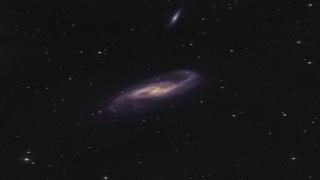Bibcode
Röck, B.; Vazdekis, A.; Peletier, R. F.; Knapen, J. H.; Falcón-Barroso, J.
Referencia bibliográfica
Monthly Notices of the Royal Astronomical Society, Volume 449, Issue 3, p.2853-2874
Fecha de publicación:
5
2015
Número de citas
50
Número de citas referidas
48
Descripción
We present the first single-burst stellar population models in the
infrared wavelength range between 2.5 and 5 μm which are exclusively
based on empirical stellar spectra. Our models take as input 180 spectra
from the stellar IRTF (Infrared Telescope Facility) library. Our final
single-burst stellar population models are calculated based on two
different sets of isochrones and various types of initial mass functions
of different slopes, ages larger than 1 Gyr and metallicities between
[Fe/H] = -0.70 and 0.26. They are made available online to the
scientific community on the MILES web page. We analyse the behaviour of
the Spitzer [3.6]-[4.5] colour calculated from our single stellar
population models and find only slight dependences on both metallicity
and age. When comparing to the colours of observed early-type galaxies,
we find a good agreement for older, more massive galaxies that resemble
a single-burst population. Younger, less massive and more metal-poor
galaxies show redder colours with respect to our models. This mismatch
can be explained by a more extended star formation history of these
galaxies which includes a metal-poor or/and young population. Moreover,
the colours derived from our models agree very well with most other
models available in this wavelength range. We confirm that the
mass-to-light ratio determined in the Spitzer [3.6] μm band changes
much less as a function of both age and metallicity than in the optical
bands.
Proyectos relacionados

Huellas de la Formación de las Galaxias: Poblaciones estelares, Dinámica y Morfología
Bienvenida a la página web del g rupo de investigación Traces of Galaxy Formation. Somos un grupo de investigación amplio, diverso y muy activo cuyo objetivo principal es entender la formación de galaxias en el Universo de una manera lo más completa posible. Con el estudio detellado de las poblaciones estelares como bandera, estamos constantemente
Anna
Ferré Mateu

Las Galaxias Espirales: Evolución y Consecuencias
Nuestro grupo pequeño esta bien conocido y respetado internacionalmente por nuestro trabajo inovativo e importante en varios aspectos de la estructura y la evolución de las galaxias espirales cercanas. Usamos principalmente observaciones en varias longitudes de onda, explotando las sinergías que nos permiten responder a las cuestiones más
Johan Hendrik
Knapen Koelstra